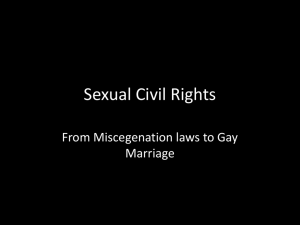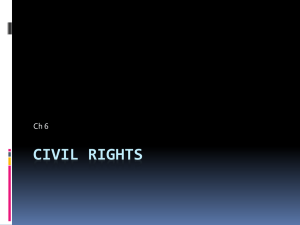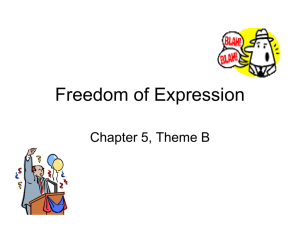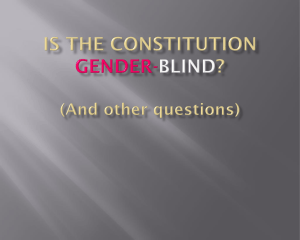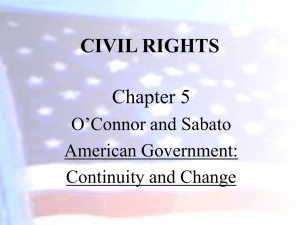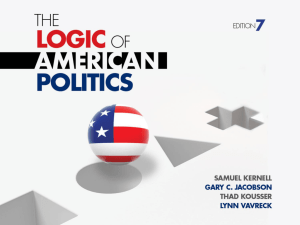Civil Rights Powerpoint from Class
advertisement
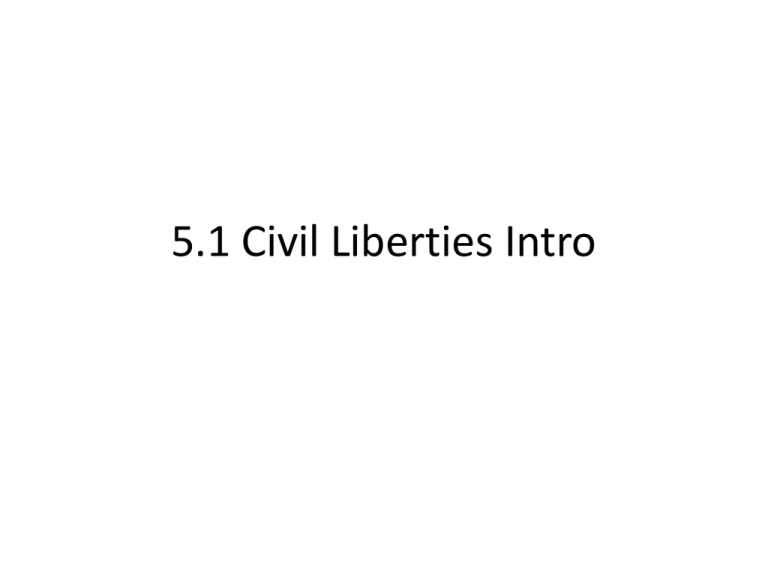
5.1 Civil Liberties Intro Intro • Rosa Parks – refused to give up her seat on the front of the bus to a white man in Montgomery, Alabama (shocker) – Arrested • Blacks and supporters of Parks boycotted the busses – Some even rode mules to work • SCOTUS ruled that this segregation violated the 14th Edwards! You are my HERO!!!1!!1 • Individual liberty is central to democracy. So is a broad notion of equality, such as that implied by the concept of “one person, one vote.” Sometimes these values conflict, as when individuals or a majority of the people want to act in a discriminatory fashion. How should we resolve such conflicts between liberty and equality? Can we have a democracy if some citizens do not enjoy basic rights to political participation or suffer discrimination in employment? Can we or should we try to remedy past discrimination against minorities and women? Civil Rights • Remember, civil liberties are rights and civil rights are laws • Get over it. Equal Rights in the Declaration • “All men are created equal.” • “Inalienable rights.” • Not equal results, but equal opportunity. – How are these different? Equal Rights in the Constitution • Doesn’t have the word ‘equality’ • 14th is the only one that mentions it – “No state shall deprive any person of life, liberty, or property w/o the DUE PROCESS of law nor deny any person the EQUAL PROTECTION of the laws” • 13, 14, 15 (starts w/ something bad. Natural progression) – 13 ends slavery – 14 equal rights for all – 15 black vote Discrimination Rules • If the discrimination is valid, the courts will uphold it – 18 to vote – 21 to drink • Gender is sometimes valid • Race is almost always invalid – Why? 5.1 Quiz a 1. How many times is the word ‘equality’ mentioned in the Constitution? 2. Which is easier to discriminate based on? 1. Race, gender or age 3. What clause in the 14th Amendment guarantees that all citizens are to be treated equally by the government? 5.1 Quiz b 1. Which is the only amendment that directly mentions equality of all citizens in the Constitution? 2. Which is harder to discriminate based on? 1. Race, gender or age 3. After losing her seat on a bus, Rosa Parks and the NAACP led a ______________ of the Montgomery bus system. 5.2 African American Civil Rights Scott v. Sandford • Dred Scott – slave who sued for his freedom – Claimed equal protection and due process (5th) • SCOTUS said he doesn’t have rights b/c he is chattel (property) – To take away slaves from owners, SCOTUS would be taking away their right to property After the Civil War • First, the federal gov ruled the south as a conquered territory – Strict rules against mistreatment of blacks • 10 years later, The Jim Crow Era begins – Laws that segregate and take rights from blacks • KKK arises as an anti black group – Saw policies of the fed gov as it overreaching Plessy v. Ferguson (Separate but Equal) • Plessy (black guy) v. Ferguson (train owner) – Plessy arrested for not leaving a white train car – SCOTUS said the 14th was ok with this – Races can be separate and still equal – Crock of crap • Racist crappy people use Plessy to justify segregation – This is a crock of crapola NAACP • National Association for the Advancement of Colored People – Early 1900s – Black and white supporters Brown v. Board of Education of Topeka Kansas (Brown v. Board) • Segregated, but black and white schools were pretty equal • NAACP chose it b/c it would challenge separate but equal (Plessy) – Argued on the side of the 14th (equal protection) • SCOTUS FINALLY DID SOMETHING RIGHT FOR A CHANGE!!! – Overturned Plessy. Said separate is not equal • Leads to quick school desegregation pushed by the federal gov • Remember, Plessy and Brown are linked. Bussing • Fed gov had some schools ‘bus’ students a long way to make schools integrated Civil Rights Act of 1964 (CRA 64) • SCOTUS (Brown) was the spark for civil rights policy and public awareness • CRA 64 – Discrimination was illegal in places of public accommodation • Anywhere anyone can shop/eat – Banned discrimination for employment • Created the EEOC (Equal Employment Opportunity Commission) – Let fed gov withold grants to states that discriminate • They can do this because of the… • Everybody…. • COMMERCE CLAUSE! 5.2 Quiz a 1. Why couldn’t Dred Scott sue for his freedom? 2. Which group does the NAACP fight for? 3. Why did Plessy sue Ferguson? 5.2 Quiz b 1. What was the first major civil rights legislation called in 1964? 2. What was the finding in Plessy v. Ferguson in three words? 3. Why couldn’t Dred Scott sue for his freedom as a slave? 5.3 Voting Rights, Native Americans, and Latin Americans Voting Rights • Suffrage – right to vote • 15th Amendment (step 2 of 3) gave African Americans the right to vote • Ways states kept black ppl from voting – Literacy tests – usually only given to black ppl • Grandfather Clause – exempted those whose grandfathers could vote (white ppl) from taking the literacy tests – Poll taxes – fee to vote (payable when poor ppl had the least money) • Voided by the 24th Amendment – White primaries – only whites could vote in primaries • Left black voters to choose from white approved candidates Voting Rights Act of 1965 (VRA 65) • Killed all the things above (except poll taxes) (24th) • Sent federal overseers to racist polling areas • Killed racial gerrymandering (drawing districts to ensure one party wins) – Said race can be one factor in drawing districts but not the only factor • Led to many more black candidates Native Americans • Dawes Act – forced assimilation of Native Americans – Made them go to schools to learn to act white/Christian • Didn’t get the right to vote until 1924 – After black ppl and women • Today high poverty and ill health • AIM – American Indian Movement – Native American NAACP Hispanic Americans • Largest minority group in America • Lynched and killed in Southwest • American GI Forum – to protect Latino veterans – Soldier was killed in battle and not allowed to be at the local funeral home • LULAC – League of United Latin American Citizens – Latino NAACP – Fought for Hernandez v. Texas b/c of all white jury • Caesar Chavez – fought for migrant workers’ rights Asian Americans • Fastest growing minority group • Korematsu v. US – MUST KNOW – Internment camps for Japanese American CITIZENS upheld by SCOTUS • “Clear and present danger” • Schenck anyone? Arab and Muslim Americans • Discrimination since 9/11 • Detainment at Guantanamo Bay, Cuba – Many American citizens – SCOTUS ruled that they deserved habeas corpus whether they were citizens or not 5.4 Women’s Civil Rights Women’s Rights Begin • The women’s rights movement began inside the abolitionist (anti-slavery) movement. • Lucretia Mott and Elizabeth Cady Stanton were early women’s rights activists. • Seneca Falls - first organized women’s rights conference. • Coverture – law that puts women below their husbands. – can’t represent themselves in court or sign contracts. Women’s Suffrage • Nineteenth Amendment gave women the right to vote. • It was signed in 1920 “Doldrums” • “Doldrums” are a place in the ocean where the winds are calm and ships can’t move with their sails. • We use “doldrums” today to describe a time when nothing happens • Time between 1920-1960 for women – Not a lot of rights gained “Protectionist Laws” • • • • Laws to “protect” women Kept their work in the homes Made men pay child support Kept them weak in society ERA Equal Rights Amendment • Equal Rights Amendment • 1970s • Guaranteed “equality of rights under the law shall not be denied or abridged by the United States or by any state on account of sex” • Couldn’t get ¾ of Congress to pass it The Feminine Mystique. • Came from surveys of middle-class women in post World War II America. • Challenged the idea that women could only be happy as wives and mothers. NOW • National Organization for Women • Purpose is to protect women’s rights Reed v. Reed • Reed v. Reed was a wife suing her husband for the rights to her dead son’s estate • The traditional owner of the son’s estate was the father, but the mother argued that she should have it because they were closer • Wife wins Today, what percentage of adult women are in the workforce? • 59% How did the Civil Rights Act of 1964 help women? • Banned gender discrimination for jobs What did Title IX of the Education Act of 1972 do for women? • Stopped gender discrimination in schools and especially in sports • This is why girls and boys sports have to have equal funding On average, how much does a woman earn for every dollar a man earns? • $0.80 on the dollar What is sexual harassment? • Unwelcome sexual advances that makes someone feel uncomfortable. • Can be extreme or mild. What are two ways women are treated differently in the military? • Only one way now – Women don’t have to register for the draft – Used to not be able to fight in combat, but that was changed in January 2013 What was Rostker v. Golberg about? What was the finding? What was the rationale for the ruling? • Rostker argued that women not having to sign up for the draft violated his Fifth Amendment right to due process. He thought that “everyone having the same process” meant that he has double the chance of being drafted because there weren’t women in the draft pool. • He lost. Waaaah. • The Court said they would let the legislature deal with it. What are the pros and cons of women serving in combat? • Pros – Some women are stronger than men – We don’t know how they will get along until we test it • Cons – Men have more upper-body strength – Men might risk others to protect women. Their “fatherly” instincts might kick in 5.4 Quiz A 1. Which amendment gave women the right to vote? 2. Where was the first women’s right conference held? 3. What was the name for the amendment that would give women equal rights to men? 5.4 Quiz B 1. How much do women make compared to men’s $1.00 per hour in America? 2. Which amendment gave women the right to vote? 3. What was the nickname for the lull in the women’s rights movement between the 1920s and 1960s? 5.5 “Other” Elderly • Social Security only is designed only to supplement income. – You pay in to gov when you work – Gov invests it – Gives it back to you when you retire • This leads elderly people to look for jobs • Elderly discrimination – More health insurance claims – Health problems/missing work “Once, blacks had to ride at the back of the bus. We can’t even get on the bus.”? • Americans with Disabilities Act doesn’t happen until the 1990s ADA 1990s • Americans with Disabilities Act • Places of public accommodation must provide “reasonable accommodations” for people with disabilities – Wheelchair ramps, braille signs, sidewalk ramps Opponents of ADA • Unfunded mandate • If the gov is going to force changes, they should help with the bill Homophobia • Technically it is the fear of homosexuals • It actually means having prejudice against homosexuals Matthew Shepard 1990s • 1998 college student that was tied to a fence and beaten with a pistol 18 times and left to die by himself • Raised awareness of gay hate crimes Stonewall Bar 1960s • Police raided the bar regularly and arrested men for being gay. This happened all the time. • Once, the people resisted arrest and a small riot broke out • Led to LBGT people to begin to fight for civil rights More gay rights issues. • 1986 – Supreme Court ruled that states could ban homosexual relations • 2013- 29 states have banned gay marriage – 16 states have legalized it • 2015 – Obergefell v. Hodges – SCOTUS said 14th guarantees all citizens the right to marry Don’t Ask Don’t Tell • 1993 – military imposed “Don’t ask, don’t tell” policy – Basically, “you can be gay, but if you act gay or tell people you are gay, we can throw you out.” • 2011 – “Don’t ask, don’t tell” was repealed Affirmative Action • Affirmative Action – efforts to include (hire/admit) people from groups that have been historically discriminated against • Goal of AA? – Move from “equal opportunity” to “equal results” • Usually happens when certain groups are given preferential treatment – Quotas are used to make sure groups are equally represented Regents v. Bakke • Bakke was a white student who didn’t get into medical school • He found out that black students were getting in with lower scores • The school had a quota to allow 16 black students in no matter what • He sued and won – But, the SC didn’t say the school couldn’t use race, it just can’t be the only thing they use SCOTUS and Affirmative Action • THE BOTTOM LINE ABOUT THE SC AND AFFIRMATIVE ACTION – race can be one of the reasons someone is hired/admitted, but it can’t be the only reason • Why can race be one of the reasons? – Because we want things to be fair for minorities Pros and Cons of Affirmative Action • Pros – Research shows that it helps minorities and doesn’t significantly hurt majorities – Helps right the wrongs of the past – Makes an even playing field • Cons – Reverse Discrimination - When people who are more qualified are overlooked because they are not in the minority – Often, people are not hired based solely on merit 5.5 Quiz A 1. Name an important affirmative action SCOTUS case. 2. Why was Matthew Shepard probably murdered? 3. What does ADA stand for? 5.4 Quiz B 1. What term means a method of giving opportunities to historically underrepresented groups for jobs and college admission? 2. Why were people arrested at the Stonewall Bar? 3. What does ADA stand for?
